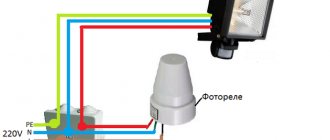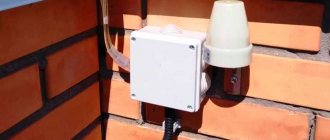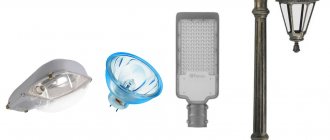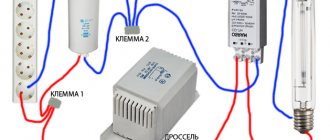Photo relay for outdoor work
This is a device with a special built-in photosensor, the task of which is to automatically activate the system for turning on and off the lighting on the street. The device is economically feasible because it operates in an energy-saving mode, turning on only on demand.
For correct operation of the device, it is necessary to carry out installation and configuration without errors. As a result of correct adjustment, the photosensor will turn on only in the dark; during the day it will enter standby mode.
To properly connect a light sensor, you need to know the device and principle of operation, its types, and also decide on a set of tools for connecting it. They will help you get acquainted with simple photo relay devices.
Operating principle of photo relay
The operating principle of the photo relay is based on the operation of a built-in photocell. Analyzing the power of the light flux on the street, the sensor turns the artificial light on and off. In the daytime, it is an insulator that opens the electrical circuit, and at dusk it is an excellent conductor.
- The design of the device is simple, it easily fits into a small housing with terminals for connecting to the mains.
- The photo sensor is designed to solve many problems, the main one of which is street illumination at night.
- Most devices are equipped with a regulator for setting certain values for the luminous flux that activates the lighting system.
- If the minimum value is set on the regulator, the photo relay will close the circuit late at night, if the maximum value is set at slight twilight, immediately after sunset. The average value will be the most acceptable, but for accurate work, several indicators are adjusted.
Types of spotlights
LED systems designed for street lighting are presented in a variety of options, including the following:
- LED spotlights, the design of which includes a motion sensor. They provide illumination for vehicles approaching a private house or garage. You can adjust the sensitivity based on your specific operating conditions. If necessary, you can also adjust the period of time during which the lamp will burn after the sensor is triggered.
- Floodlights using motion sensors powered by solar panels. This scheme is very convenient when there is no possibility of connecting to the electrical network. Used to illuminate areas where light sources operating in autonomous mode are installed. The solar panel is installed separately so that it captures the maximum amount of solar radiation. During the daytime, energy accumulates and is used up at nightfall.
- Spotlights with halogen lamps, equipped with infrared motion sensors that respond to the thermal radiation of an object. These devices operate at a distance of up to 12 meters without loss of functionality at low temperatures and other adverse weather conditions.
Main technical characteristics of photo relay
- The supply voltage for street lamps is 220 V;
- The switching current depends on the number of connected consumers (defined as the ratio of the sum of the power of all lamps to the supply voltage) and should not exceed 10 A for uninterrupted operation;
- The power range of the device is 1-4 kW depending on active or passive operation (standby mode);
The illumination range is controlled by the regulator. The sensor's power is turned on at the lower limit, corresponding to 2 lux (pitch darkness) and at the upper limit - 100 lux - it is turned off. The actual values of the work lie in a slightly different area - 10-80 lux.
Debunking myths about solar lanterns
Opponents of solar-powered lamps for street lighting argue that such devices cannot compete with electric lamps. But does it make sense to compare them at all? They are originally designed for different purposes.
Comparing electric lamps and solar-powered lanterns is incorrect. They give completely different light. The first ones are bright and sharp, the second ones are muted and soft.
The purpose of electric lamps is to provide bright contrasting light, thanks to which you can see all the details. But solar-powered lanterns have a completely different function - to illuminate the area so that you can navigate normally in the evening and at night.
They are not intended to illuminate areas where active activities requiring attention and precision are planned.
Solar-powered lanterns should not be considered an adequate alternative to electric ones. They highlight and decorate the area, create an atmosphere of calm and romance, but are not able to create areas of bright light
Flashlights based on photocells cannot compete with electrical devices in terms of brightness, so it makes sense to organize combined lighting.
For example, an electric lamp is appropriate above the porch of a house. To increase ease of use and save energy, it can be supplemented with a motion sensor or photosensitive relay. And paths, lawns, and gardens can be illuminated with solar-powered lamps.
When arranging a combined system, you need to remember that the electric light blocks the solar lights.
Combined lighting will be successful if electric and solar lamps illuminate different areas and do not overlap each other. By choosing the right devices in terms of brightness and color, you can organize smooth transitions
The intensity and duration of operation of autonomous solar street lights largely depends on the weather.
If it is cloudy during the day, you cannot expect good and long-lasting light in the evening, because... To fully charge the battery, it takes 8-10 hours and good sunlight. This is the main disadvantage of photocell street lights.
Main types of light sensors
There are external and internal sensors. According to the design features, the photocell is located either inside the housing or outside it:
- External sensor. The mechanism of the device is divided into two sections - a switch and a photocell, connected into a single circuit. Such a lighting sensor is used in complex configurations, so it is important to have a good understanding of the circuitry of the panel that activates and regulates the operation of street lighting;
- Internal sensor. The most common standard type of photo relay, inside of which there is a photocell and an activation timer. Thanks to it, you can configure how to turn the device on and off. As a result of the timer operation, the street lighting is activated at the set time, which makes it possible not only to reduce energy costs, but also to increase the service life of the device itself.
Principle of operation
- Photoresistor. When irradiated with light, the level of its resistance changes
- Phototransistor. Depending on the intensity of natural light, the output signal is regulated
- Photodiode. Converts natural light entering a sensitive area into an electrical signal
- Phototriac. Synchronizes currents and performs the functions of transmitting them to the working electrodes
- Photothyristor. Under the influence of light, it connects the photo relay to direct electric current, including street lighting
Types of photo relays with additional functions
- Device name
- Functions performed
- Combined photocell with timer
- The device allows you to configure the relay operation according to time. Lights turn on and off at certain hours
- Light relay with motion sensor
- The device turns on only when there is movement
- Programmable sensors
- This option uses combined settings
Advantages and disadvantages
Installing lighting for a yard, garden, or local area is expensive - you not only need to install lamps, but also lay cables. Underground cable laying is more reliable, which means a large amount of excavation work, plus significant costs for the cable, since it must be in a protective sheath, or better yet, armored. But that’s not all - during operation you have to pay hefty electricity bills - the lighting works every day, for 6-8 hours. Solar-powered street lighting can partially solve the problem.
Such lighting can be done using ordinary lamps and a cable stretched between them, or by installing solar-powered lamps
Advantages
Why partially? Because the most “critical” areas (gates, parking, entrance doors) will have to be illuminated permanently - it’s more reliable. But on the rest of the area you can install solar-powered lamps. They have a number of advantages.
- Solar-powered lamps are usually self-contained and do not need to be connected anywhere. They are installed/hung in the right places, the installation is completed, they are ready for work.
- They turn on/off themselves, from the built-in sensors. Ease of installation and safety are two big advantages
- They require minimal maintenance - you need to periodically wipe the photocells and lampshade from dust and dirt.
- They have a long service life - from 10 years or more (with proper quality).
- They do not harm the environment and are absolutely safe, as they operate on low voltage, which is not dangerous to humans.
- If solar-powered street lighting is made in a country house, preserving it for the winter and installing it takes very little time. You just need to collect the lamps before leaving and arrange them upon arrival.
Flaws
As you can see, there are many advantages, the main one being energy savings and very simple installation/dismantling. But there are also disadvantages:
- Solar-powered garden and street lamps usually produce not very bright light. They cannot be used as security lighting. More precisely, there are powerful models that are even used for lighting highways, but their cost is completely inhumane, which is why their use in private backyards is very limited. Solar street lighting is usually not very bright
- The number of operating hours at night depends on the weather: in cloudy, rainy weather, the lamps “store” too little energy. Sometimes it only lasts for a few hours, and not for the whole night.
- Reliable solar-powered lamps are expensive, but they work more reliably and longer.
- Solar panels have a limited operating temperature range. They do not tolerate severe frosts and extreme heat. Therefore, they can be optimally used in areas with a temperate climate.
As you can see, the option is not ideal, but it really helps to save on electricity, because standard lighting of critical areas is far from half the cost of general lighting of the yard and garden.
Astro timer
A device programmed for different time zones, responding to sunrise or sunset. A specific belt is selected for operation, and the device operates automatically. Does not depend on installation location
Having learned information about the types of sensors, you need to study the theory of how to connect a photo relay.
Possible connection diagrams
Light sensors are usually installed close to the light source, the operation of which they must activate and regulate.
For the device to work correctly, artificial light should not fall on it.
- It is important to accurately connect the contacts coming out of the photo relay housing.
- The blue conductor points to zero; in addition, the wire from the lighting device is connected through it.
- Red regulates the sensor and is passed to the consumer through the internal regulator.
- To activate the device from the mains current, a brown wire (phase) is used.
Sometimes, when using a lighting system, the circuit contains an additional conductor that acts as grounding. It connects directly to a lamp or spotlight.
The marking of conductors may vary depending on the manufacturer, but connecting zero and phase always has the same algorithm. Therefore, a do-it-yourself photo relay wiring diagram will not look like a complicated process. You can connect the device to lighting without any specific skills.
Installation of a solar-powered lamp
Solar-powered street lamps can have different shapes, appearances, and installation methods, but they all consist of a certain set of elements:
- Solar panel or battery. A device that converts solar energy into electrical energy. It may be located on different parts of the lamp, but it is turned upward to better capture the sun's rays.
- Battery. Electrical energy accumulates in it during daylight hours. Installation of a solar-powered lamp
- Lighting block. This is usually a housing, an LED lamp and a lampshade.
- A controller that turns on/off the power supply to the lighting unit.
- Mounting/hanging mount.
As you understand, the principle of operation is this: during daylight hours, the sun's rays are captured by the solar panel, where they are converted into electrical energy and transmitted to the battery. When twilight sets in (illuminance 20 Lux), the controller turns on the power supply and the LED lamp lights up. In the morning at dawn (at illumination of 10 Lux) the lighting is turned off.
Step-by-step instructions for connecting a photo relay
When installing a street lighting system, instructions will help that will tell you how to quickly and correctly carry out the work:
- Install the distribution panel. Installation is usually carried out on the wall.
- Connect the photo relay using the diagram from the technical documentation supplied with the device. Install the mounting bracket in a place where the solar rays fall on the photocell, excluding other light sources.
- Adjust the system using a regulator - select the indicators of the light sensor’s response to certain changes in illumination.
- Install the regulator on the external part with the required characteristics: response range 5-10 lux; power – 1-4 kW, switching current no more than 10 A.
Depending on the difficulty of installation, relays are divided into several types. The most common is the one with a built-in timer. The installation sequence is the same for all photo relays; it is important to identify zero and phase.
Characteristics and selection
It is also necessary to select a photorelay model based on the power of the lamps connected to it (output power) and load current. It, of course, can “pull” the load a little more, but this can cause problems. So it’s better to take it even with some reserve. These were the mandatory parameters by which you need to choose a photo relay for street lighting. There are a few more additional ones.
Characteristics of photo relay for street lighting
In some models, it is possible to adjust the response threshold - to make the photosensor more or less sensitive. It is worth reducing the sensitivity when snow falls. In this case, the light reflected from the snow can be perceived as dawn. As a result, the light will turn on and off. This performance is unlikely to please.
What kind of lighting do you prefer?
Built-in Chandelier
Pay attention to the sensitivity adjustment limits. They may be larger or smaller. For example, for the Belarusian-made AWZ-30 photo relay this parameter is 2-100 Lux, for the P02 photocell the adjustment range is 10-100 Lux.
Response delay. Why is the delay needed? To avoid false switching on/off of light. For example, at night the photo relay was hit by the headlights of a passing car. If the response delay is short, the light will turn off. If it is sufficient - at least 5-10 seconds, then this will not happen.











